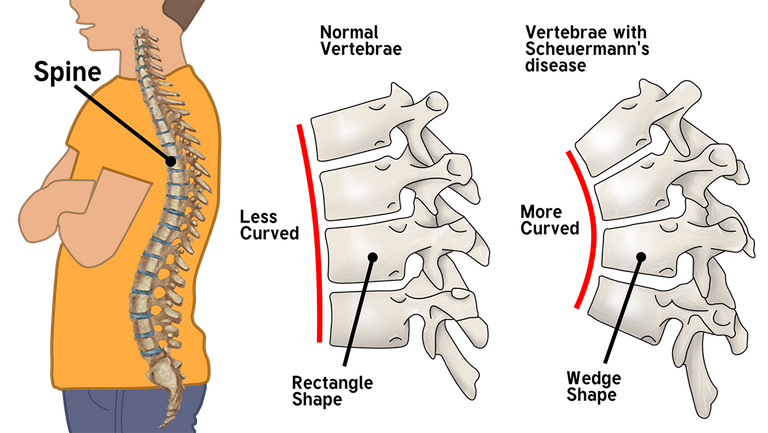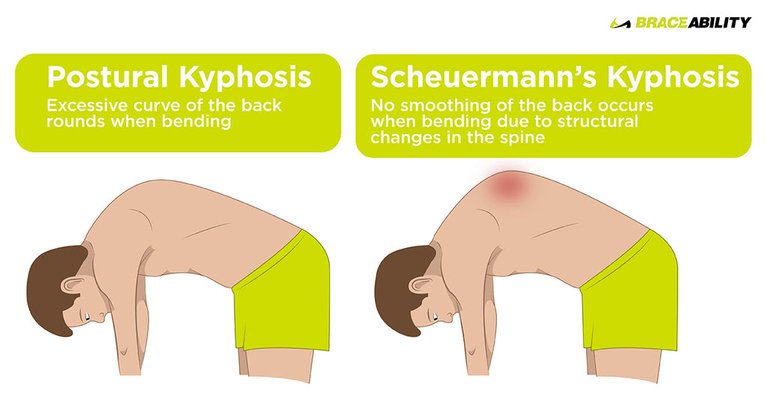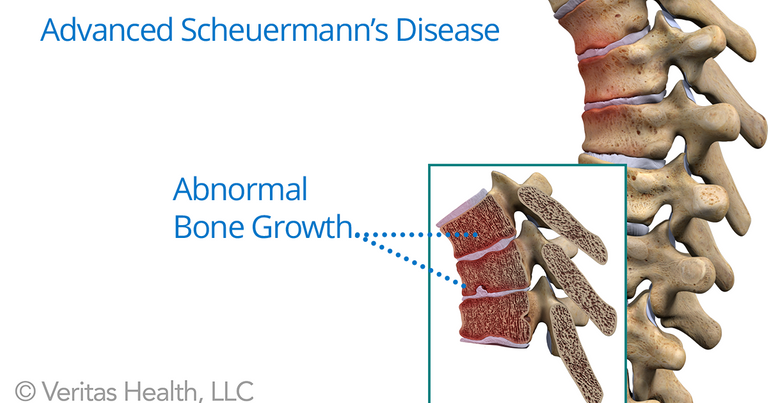What exactly is Scheuermann's Disease? // O que afinal é a Doença de Scheuermann?
The discomfort in my back is almost like a kind of inhabiting entity of me. The pain itself is fractional during the day, sometimes it hurts a lot, sometimes a little, rarely it doesn't hurt, but it's a pain that comes with me for years and years, and how long did it take me to understand that this pain could have some meaning, any logic, any origin other than a supposed bad posture that solidified in adolescence? I write this text twisting myself this way and that like a person who is stuck in an eternal stage of rusty stretching, but who finds temporary relief in the stretching of the back muscles, in addition to the crackling in their vertebrae, which when they are achieved bring significant relief for a few minutes. It took years for me to finally do some more detailed exams (tomography, digital radiography, etc), in the midst of a crisis of intense pain in a very specific muscle that is literally next to the damn vertebra. Yes, cursed, or could you call her cursed? My T12 vertebra happens to have a rare (possibly genetic) anomaly (or so it is known at the time), called Vertebral Epiphysitis or Scheuermann's Disease. Because I? I don't know, but who knows how to write about it, I'll be willing to find more answers and that's exactly what I intend to do!

Source
Holger Scheuermann was the Danish surgeon who first described such kyphosis caused by a flattening of the vertebra apparently arising from the skeletal growth self-limiting system without necessarily external relations, and seen predominantly in young people. Later this specific syndrome was named after the doctor himself to "honor" him. This disease is considered a "juvenile osteochondrosis", which as I explained, probably has a genetic character, and causes some specific bones to end up, in the rapid growth phase (humans in the growth phase, and some other animals as well) to end up having a compromise in the blood circulation that irrigates some vertebrae and causes them to stagnate growth in one of their angles, but keep growing in another and after the process, return to irrigation and growth in the "missing part" thus making some irregularities in the structure vertebral bone, which usually generates even less space for the cartilages (which are our shock absorbers between each vertebra) to develop and work properly. Unlike classic kyphosis, patients with this disease cannot maintain the expected "postural correction" for hours, days, months until it is corrected, because correcting the angle creates a kind of poorly organized stacking in the vertebrae, given that one or most of them are irregular in angle, so the tendency to "rest" is literally and solidly to hang forward and this will vary to different degrees depending on the size of the person's problem. The constant feeling of needing postural correction, cracking the bones and stretching, straining backwards probably makes the pain worse, mainly due to muscle strains that are not always prepared to stretch. Aesthetically speaking, this type of Scheuermann's kyphosis gives the person a hunchbacked appearance, with "the weight of the world" on the back and even compromises the affected person's perception of size, which when in a 100% correct and elongated posture, can have ( like me) 1.84 meters, but in moments of "postural fatigue" they even decrease 3 to 5 centimeters in height.

Source
The problem does not end there, therefore, Scheuermann's disease also ends up causing a sharp curvature in the lumbar, known as "lordosis", which is a kind of natural course of the spine trying to correct the vertebral imbalance at the top. In addition, almost inevitably, the bearer of this disease has what we know as a "barrel chest", which is an accentuated, more rounded shape of the rib cage, often when well cared for in aesthetic and gymnastic terms, it can only appear to have a strong chest. and favored posture. The barrel chest, in turn, ends up giving the carrier of the disease a greater lung capacity than in people in general and in spirometry tests they usually get better results (I conclude that possibly in apnea tests too?), is this an advantage? I like to think so, even though I've always hated the shape of my chest. At least I have a nice long breath. In addition, we have another detail, the hamstring muscles of the carrier of the disease are also usually larger and more advantageous than those of an average person, and again, this is the body's natural compensation to resist and balance the postural problems caused by the syndrome. Again, in this case it doesn't seem to be a bad thing (I've always considered my legs beautiful, haha), there are some researchers who even theorize that Scheuermann's whole problem comes from these larger and tighter muscles, which are firmer, which in a sequence of compensation ends up causing a muscular postural curvature that would lead to the initial problem of vertebral pressure and its deformation in the growth phase, but these are theories, just theories for now. And that kind of "doesn't solve anything". But returning to the "negative points", carriers of the disease may also be more prone to osteoporosis, for example, and in this case, for unknown reasons (but I suppose they are part of the plugin - damn genetic disease).

Source
Speaking now about the causes of the syndrome, the genetic assumption is as uncertain as any other theory, but it is one of the most accepted. Although many professionals argue that Scheuermann's disease is multifactorial and that some oscillation in the growth process, hormones and other things may be involved, it is known that it is commonly passed on genetically. Some theories have already been discarded, such as that the problem is linked to the FBN1 gene (the same as in Marfan syndrome). Now, in terms of treatment, when the disease is observed early, a lot can be done to correct this type of severe kyphosis to a good degree. But if you, like me, were a teenager who didn't even want to worry about it and didn't care about the posture and hated when it was "corrected" and didn't have enough family pressure to fix it or be forced to go to a doctor check this earlier, now my friend, you have only two paths left: A life of constant care of muscle strengthening for the back (gym), efficient alternative treatments like RPG, Pilates, Yoga and the occasional use of a vest to educate the posture ( for a few hours a day so as not to cause muscle decompensation in other points of the back) and also physical therapy OR resorting to surgery (which is obviously the last solution, for severe cases). Surgery for postural problems should only be a solution in situations where the person's pain is constant and debilitating, or even if their kyphosis is somehow compromising other internal organs. In my case, the best results I've had so far were from the phases where I did weight training at least three times a week with an emphasis on the back muscles, in addition to a lot of stretching, yoga (with care and attention, because it's VERY EASY to hurt in the muscle strains that are around the affected area and feel like stretched guitar strings).

Source
Well, that's all I could bring you on the subject, and I did it with great care and attention, I hope you enjoyed reading it. If you have back/postural problems and variants, I would love to read your report! Thanks for the visit!
Articles used in this research: 1, 2, 3, 4 e 5.

Português
O incômodo nas costas é quase como uma espécie de entidade habitante de mim. A dor em si é fracionada durante o dia, às vezes dói bastante, as vezes pouco, raramente não dói, mas é uma dor que vem comigo de anos e anos, e quanto tempo aliás levei para compreender que essa dor poderia ter algum significado, alguma lógica, alguma origem além de uma suposta má postura que se solidificou na adolescência? Escrevo esse texto torcendo-me para um lado e para outro como uma pessoa que está presa em um eterno estágio de alongamento enferrujado, mas que tem na esticada de músculos das costas o temporário alívio, além dos estalos em suas vértebras, que quando são alcançados trazem um alívio significativo por alguns minutos. Levaram anos para que eu enfim fizesse alguns exames mais detalhados (tomografia, radiografia digital, etc), em meio a uma crise de dor intensa num músculo muito específico que fica literalmente ao lado da vértebra maldita. Sim, maldita, ou poderia chamá-la de amaldiçoada? Por acaso minha vértebra T12 possui uma anomalia (possivelmente genética) rara (ou assim sabe-se até então), chamada Epifisite Vertebral ou Doença de Scheuermann. Por que eu? Não sei, mas quem sabe escrever sobre isso me disponha a encontrar mais respostas e é exatamente o que pretendo fazer!

Source
Holger Scheuermann foi o cirurgião dinamarquês que primeiro descreveu a tal cifose causada por um achatamento de vértebra aparentemente advindo do sistema de auto-limite de crescimento esquelético sem relações necessariamente externas, e visto prevalentemente em jovens. Mais tarde tal síndrome específica ganhou o nome do próprio médico para "homenageá-lo". A tal doença é considerada uma "osteocondrose juvenil", que como expliquei, provavelmente tem caráter genético, e faz com que alguns ossos específicos acabem por, na fase de rápido crescimento (humanos na fase do crescimento, e alguns outros animais também) acabem por ter um comprometimento na circulação sanguínea que irriga algumas vértebras e fazem com que estas estagnem o crescimento em um dos seus ângulos, porém sigam crescendo em outro e após o processo, voltem a irrigação e crescimento na "parte faltante" fazendo assim algumas irregularidades na estrutura óssea vertebral, o que costuma gerar inclusive menos espaço para as cartilagens (que são nossos amortecedores entre cada vértebra) desenvolverem-se e trabalharem corretamente. Diferente da cifose clássica, os portadores dessa doença não conseguem manter a esperada "correção postural" por horas, dias, meses até que esteja corrigida, porque ao corrigir o ângulo cria-se uma espécie de empilhamento mal organizado nas vértebras, dado que uma ou mais delas são irregulares em ângulo, de forma que a tendência de "descanso" é literalmente e solidamente, manter-se pendente para frente e isso vai variar em diferentes graus, dependendo do tamanho do problema da pessoa. A constante sensação de necessidade de correção postural, de estalar os ossos e de alongar-se, tensionando-se para trás torna provavelmente a dor pior principalmente pelos estiramentos musculares que nem sempre estão preparados para alongar-se. Esteticamente falando esse tipo de cifose de Scheuermann dá um aspecto corcunda para a pessoa, de "peso do mundo" nas costas e inclusive, compromete a percepção de tamanho da pessoa afetada, que quando está numa postura 100% correta e alongada, pode ter (como eu) 1,84metros, mas nos momentos de "cansaço postural" diminuem até mesmo uns 3 a 5 centímetros de altura.

Source
O problema não acaba por aí, por consequência, a doença de Scheuermann acaba causando também uma curvatura acentuada na lombar, conhecida como "lordose", que é uma espécie de rumo natural da coluna tentando corrigir o desequilíbrio vertebral da parte de cima. Além disso, quase que inevitavelmente o portador dessa doença tem o que conhecemos por "tórax em tonel", que é um formato acentuado, mais arredondado da caixa toráxica, muitas vezes quando bem cuidada em termos estéticos e ginásticos, pode aparentar apenas um tórax forte e de postura favorecida. O tórax em tonel por sua vez acaba dando ao portador da doença uma capacidade pulmonar maior que nas pessoas em geral e em testes de espirometria costumam tirar resultados melhor (concluo que possivelmente em testes de apneia também?), será isso uma vantagem? Gosto de imaginar que sim, apesar de sempre ter odiado o formato de meu tórax. Ao menos tenho uma bela e longa respiração. Além disso ainda temos outro detalhe, os músculos isquiossurais do portador da doença costumam ser também maiores e mais avantajados do que de uma pessoa mediana, e novamente, isso se dá como compensação natural do corpo para resistir e equilibrar os problemas posturais causados pela síndrome. Novamente, nesse caso não parece ser algo ruim (inclusive sempre considerei minhas pernas bonitas, haha), existem alguns pesquisadores que inclusive teorizam que o problema todo de Scheuermann advém desses músculos maiores e tensionados, mais firmes que numa sequência de compensações acaba por causar uma curvatura postural muscular que levaria ao problema inicial da pressão vertebral e sua deformação em fase de crescimento, mas são teorias, apenas teorias por enquanto. E isso meio que "não resolve nada". Mas voltando aos "pontos negativos", os portadores da doença podem também ter maior propensão à osteoporose por exemplo e nesse caso, por questões desconhecidas (mas suponho que sejam parte do plugin - doença genética maldita).

Source
Falando agora sobre as causas da síndrome, a suposição genética é tão incerta quanto qualquer outra teoria, porém é uma das mais aceitas. Ainda que muitos profissionais defendam que a doença de Scheuermann seja multifatorial e que alguma oscilação no processo de crescimento, nos hormônios e outras coisas possam estar envolvidas, sabe-se que comumente é passada geneticamente. Algumas teorias já foram descartadas, como por exemplo a de que o problema está atrelado ao gene FBN1 (o mesmo da síndrome de Marfan). Agora, pensando em termos de tratamento, quando a doença é observada cedo, muita coisa pode ser feita para corrigir em um bom nível esse tipo de cifose severa. Mas se você assim como eu foi um adolescente que não queria nem saber de se preocupar com isso e não estava nem aí para a postura e odiava quando era "corrigido" e não teve pressão familiar suficiente para tomar jeito ou ser obrigado a ir num médico verificar isso mais cedo, agora meu amigo, lhe resta apenas dois caminhos: Uma vida de cuidado constante de fortalecimento muscular para as costas (academia), tratamentos alternativos eficientes como RPG, Pilates, Yoga e o ocasional uso de colete para educar a postura (por poucas horas por dia para não causar descompensação muscular em outros pontos das costas) e também fisioterapia OU então apelar para a cirurgia (que obviamente é a última solução, para casos graves). A Cirurgia para problemas posturais só deve ser uma solução em situações onde a dor da pessoa é constante e debilitante, ou ainda que de alguma forma a sua cifose esteja comprometendo outros órgãos internos. No meu caso, os melhores resultados que já tive até então foram das fases onde eu fazia musculação ao menos três vezes na semana com ênfase na musculatura das costas, além de muito alongamento, yoga (com cuidado e atenção, por que é MUITO FÁCIL se machucar nos estiramentos musculares que estão em volta da região afetada e parecem cordas de violão esticadíssimas).

Source
Bom, isso é tudo que pude trazer para vocês sobre o tema, e o fiz com muito cuidado e atenção, espero que tenham gostado da leitura. Se você tem problemas de coluna/posturais e variantes, adoraria ler seu relato! Obrigado pela visita!
Artigos utilizados nessa pesquisa: 1, 2, 3, 4 e 5.
Obrigado por promover a comunidade Hive-BR em suas postagens.
Vamos seguir fortalecendo a Hive
Eu tenho um amigo com esse tipo de formação da coluna, desde jovem era bem corcunda e com essa diferença no torax! Para teu alivio, eu nao tenho ela mas tenho muitos problemas na coluna desde jovem lol

!1UP
You have received a 1UP from @gwajnberg!
@stem-curator, @vyb-curator, @pob-curator, @neoxag-curator, @cent-curator
And they will bring !PIZZA 🍕.
Learn more about our delegation service to earn daily rewards. Join the Cartel on Discord.
Thanks for your contribution to the STEMsocial community. Feel free to join us on discord to get to know the rest of us!
Please consider delegating to the @stemsocial account (85% of the curation rewards are returned).
You may also include @stemsocial as a beneficiary of the rewards of this post to get a stronger support.